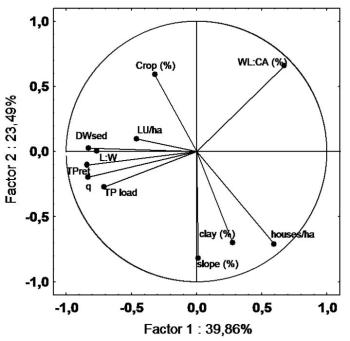
Results and discussion
Net sedimentation varied between 0.8 and 9 kg m-2 yr-1
P retention varied between 0.8 and 15 g m-2 yr-1
High P load was, as expected positively correlated to P retention.
High hydraulic load increased particle and particle-bound P retention up to ≈ 1.5 m day-1. A high hydraulic load would give high specific P and particle load which would explain these relationships. Other than this it was not possible to pinpoint any specific catchment factor as being of specific importance. However, at to high loads a high water velocity would lead to particles and P being transported through the wetlands, and possibly resuspension.

different shapes
There was a positive correlation between a larger length:width ratio and retention. Larger length:width ratio increased retention. In the wider wetlands the waters pathway probably resulted in "dead zones" were particles and particle-bound P would not reach.
Neither catchment slope, nor clay content in soil had an impact on area specific particle nor particle-bound P retention. In addition there was no correlation between clay content in soil and sediment P concentration.
The lack of correlation with clay content in soil implies that clay particles did not settle in the studied wetlands. Similarities in sediment P concentration suggested that similar sized particles settled within these wetlands.

Generally sedimentation & P retention decreased from inlet to outlet.
There was a negative correlation between proportion of crop in catchment and phosphorus settling distance. This could possibly be due to soil tillage breaking up soil aggregates since there trend was similar for particle settling distance.
Responsible for this page:
Director of undergraduate studies Biology
Last updated:
01/12/12
